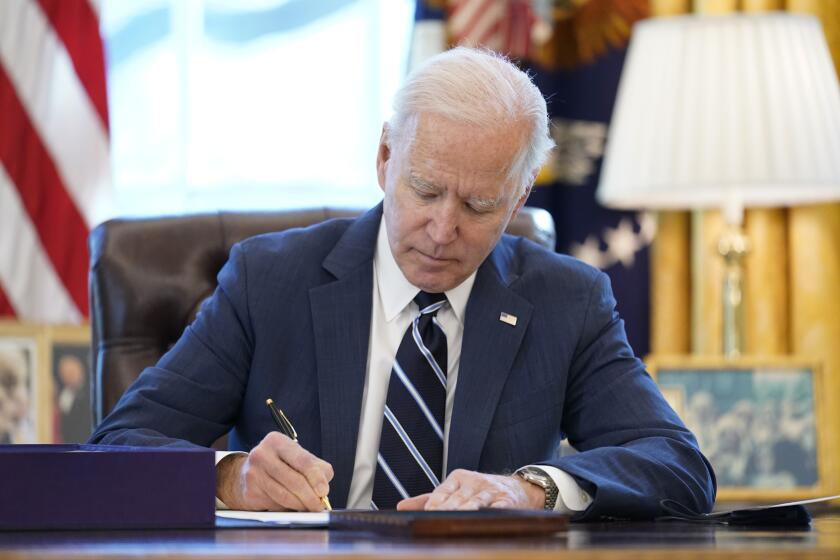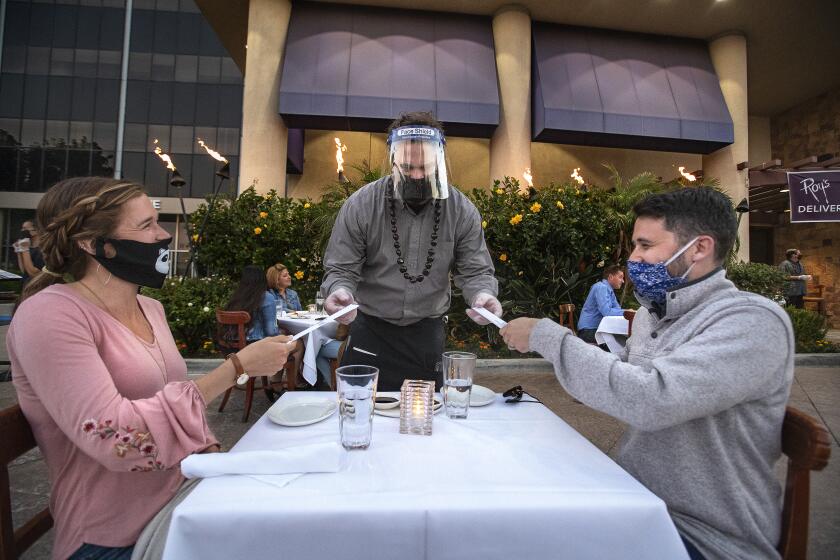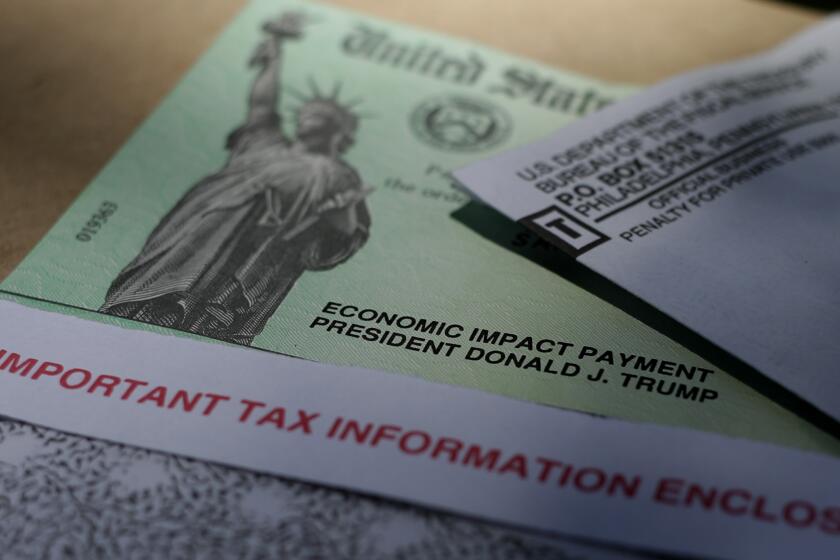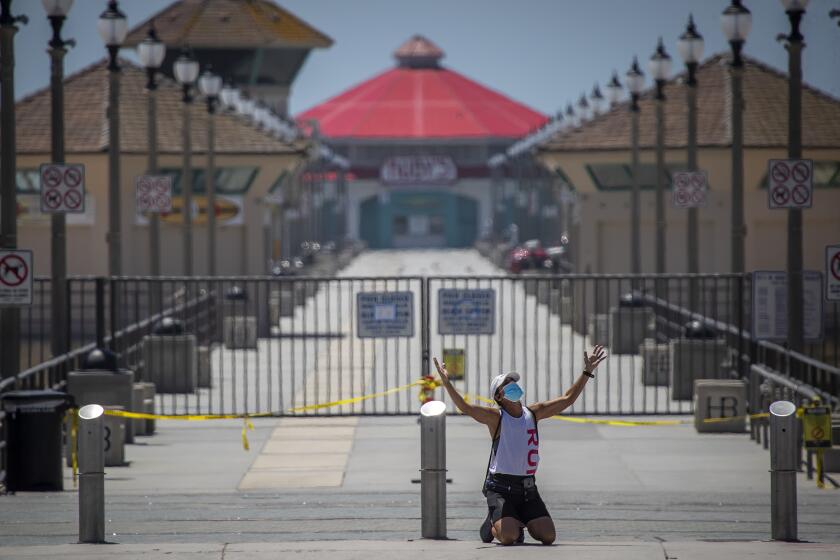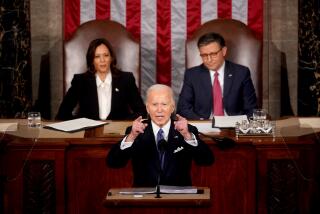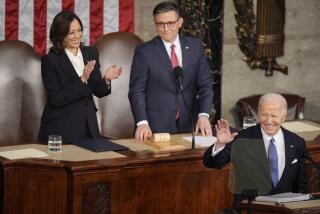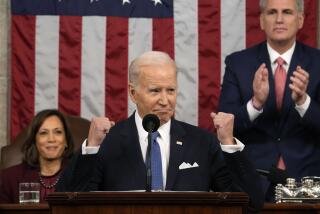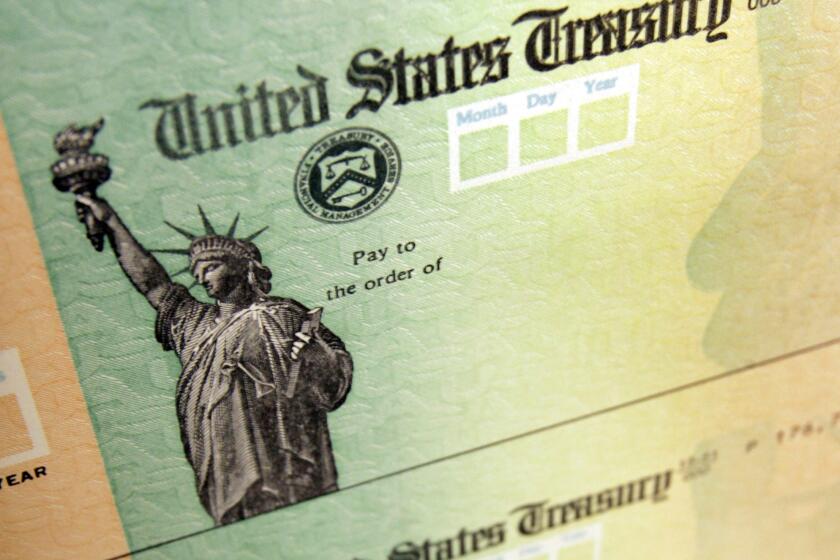Biden projects hope in speech: All adults can be vaccinated by end of May

After a grim winter, Biden seeks to foster a surge of optimism about the pandemic, the economy and national unity.
- Share via
WASHINGTON — After a grim winter that saw the U.S. death toll from COVID-19 rise past half a million, President Biden sought to foster — and benefit from — a national surge of optimism about the pandemic, the economy and the country’s condition in a White House speech Thursday evening.
By May 1, restrictions on who can make a COVID-19 vaccine appointment will be lifted nationwide, Biden said. The current limitations no longer will be needed because vaccine supply will be adequate to meet demand. All American adults should be able to get at least a first shot by the end of May, officials said.
The goal is to have a nation “closer to normal” by the Fourth of July, with at least “small gatherings” on Independence Day, Biden said, holding out the prospect of backyard barbecues “when we not only mark our independence as a nation, but we begin to mark our independence from this virus.”
But he prefaced that with an appeal to Americans to “do their part.”
“I need you — you, the American people. I need you,” Biden said, urging Americans to get vaccinated when their turn comes and to help others do so.
The speech from the White House East Room, which ran a bit over 20 minutes, came just hours after Biden signed into law a $1.9-trillion recovery package that his administration says will speed the pace of vaccinations, help get schools reopened safely and deliver significant financial aid to low- and middle-income families.
Biden signs the nearly $1.9-trillion COVID relief package into law, authorizing a massive infusion of federal aid aimed primarily at working families.
His remarks contained somber notes — Biden read from a note card he drew from his pocket that 527,726 Americans had died of the disease as of Thursday morning. And he denounced violence against Asian Americans, who have been scapegoated, he said.
But the overall tone was one of optimism for the nation’s future.
“After one full year, there is hope and light for better days ahead,” he said.
“I know it’s been hard. I truly know,” he said. But he added that “finding light in the darkness is a very American thing to do. In fact, it may be the most American thing we do. And that’s exactly what we’ve done.”
Senior White House officials, briefing reporters before the speech, explained how the new goals would be met. Although states set the rules for who can get shots, the federal government controls the vaccine supply; if necessary, Biden can use that authority to direct states to drop restrictions as of May 1, they said.
To speed vaccinations, Biden will expand the pool of medical professionals allowed to administer shots to include dentists, EMTs, paramedics, physician assistants and even veterinarians. The government will double the number of community health centers and mass vaccination sites in the coming weeks.
Restaurants, gyms, museums and movie theaters in Los Angeles County will be allowed to reopen for indoor activity, according to a public health order announced Thursday that marks the first major reopening of businesses since the start of the pandemic.
Also, some 4,000 additional troops will be deployed to help with the vaccination campaign, and the federal government will launch a website and call center to help people find appointments, Biden said.
The president’s more upbeat tone marked a notable pivot. In December he’d warned that the “darkest days in the battle against COVID are ahead of us,” and since then he has repeatedly downplayed expectations for when the country would return to normal.
The speech, Biden’s first in prime time from the White House, marked the one-year anniversary of the World Health Organization’s declaration of COVID-19 as a pandemic.
Earlier, in the brief Oval Office signing ceremony for the massive pandemic relief law — a larger celebration will come Friday — Biden said the package was about “rebuilding the backbone of this country.”
The law will provide $1,400 payments to most Americans in the next few weeks, with the first wave landing in bank accounts as soon as this weekend, White House Press Secretary Jen Psaki said Thursday.
The measure will also achieve a list of Democratic goals, including creating for one year a near-universal child benefit that experts project will cut the child poverty rate nearly in half.
The $1.9-trillion COVID-19 relief bill will benefit Californians at local, state and federal levels. Here’s how it will affect you personally.
The law will reduce the overall poverty rate by more than one-third in the coming year, according to a new analysis from the Washington-based Urban Institute. That would be by far the largest single-year drop in poverty in the last decade and one of the biggest in modern U.S. history.
Enactment of the law marks a significant victory for Biden — the package emerged from Congress at roughly the same size he proposed in January, its major components intact with the exception of an increase in the federal minimum wage, which Senate rules dictated be handled separately.
Over the next week, Biden and other top officials will seek to highlight elements of the new law — something he said last week President Obama had not done enough of in 2009, after passage of his economic stimulus law.
Biden is scheduled to travel next week to the Philadelphia suburbs — a traditionally Republican area where he had strong appeal among moderate voters, while Vice President Kamala Harris hits the swing states of Colorado and Nevada. The two have a joint appearance scheduled for the end of next week in Atlanta, another politically crucial locale.
At each stop, administration officials are expected to emphasize how Americans can access the aid provided under the new law.
Thursday’s more hopeful tone stood in sharp contrast with his presidential campaign, in which Biden hewed to a sober approach designed to counter President Trump’s downplaying of the disease, which many voters found cavalier.
Southern California is used to bouncing back from earthquakes, wildfires and other disasters, but COVID-19 brought crisis upon crisis — “cascading collective trauma,” some scientists called it.
Biden also lowered expectations after taking office, allowing him to under-promise and over-deliver, a formula that his predecessor seldom followed because of his tendency to oversell.
In recent weeks, however, Biden and his administration have increasingly struck a sunnier note. The shift began just over a week ago when Biden announced that the country would have enough vaccine to give shots to all adults by the end of May.
“Every day the number of vaccines goes out, and when you have that kind of visible forward progress, it’s hard to argue against it,” said Donna Edwards, a former Democratic member of Congress from Maryland.
The change in tone is something that several Democratic strategists have been urging.
“They’ve been a bit too negative,” Democratic pollster Anna Greenberg said before Biden’s speech. “Some optimism from him would be good.”
Although Americans remain guarded about how quickly the country can return to normal, a new Gallup poll showed the share of Americans expressing satisfaction with their lives recovering nearly to pre-pandemic levels.
Republican strategist Sarah Longwell has seen that shift in focus groups she’s conducted with voters who backed Donald Trump in 2016 then switched to Biden last year.
“When I asked the question [in 2020], ‘How do you think things are going in the country?’ the answers were brutal,” Longwell said. People would talk about friends or family members dying and not being able to visit them or about people being laid off, she recalled.
By contrast, at her latest group, six people in a row “all said, ‘I’m feeling pretty good. I think things are headed in the right direction,’” she said.
“There’s a sense of being on the cusp,” Longwell added. And while voters remain skeptical of political promises, “checks landing in people’s mailboxes” are the sort of thing likely to get attention.
Biden’s task of promoting his legislative package is in several ways easier than the one Obama faced a decade ago. In Obama’s case, the Great Recession was still deepening through much of his first year in office — unemployment did not peak until October 2009. Voters at the time were extremely skittish about risk, said Joel Benenson, who was Obama’s pollster.
That wariness significantly limited the size of any program the country would support, Benenson said. It also gave the Republicans ground from which to attack Obama’s proposals.
By contrast, Biden’s way has been eased by the inability of Republicans so far to develop effective attacks.
In time that will change, said Greenberg. “You can see the Republicans flailing around,” but with a measure this big, “inevitably, there will be something.”
For now, however, the bill “just hasn’t stirred the sort of opposition that Obama’s stimulus did,” said Republican strategist Alex Conant.
All that is reflected in polls that show the legislation supported by around 70% of the public. Biden’s own approval rating is not at quite such a lofty level and probably never will be, given the nation’s intense political polarization.
“The days of 57%, 58%, 59% approval ratings are probably gone,” said Benenson. “Social media has served to just completely Balkanize the country.”
But Biden has maintained a steady majority of the public behind him. A poll released Thursday by the nonpartisan Pew Research Center found 54% of the public approving of Biden’s job performance so far, with 42% disapproving.
The poll also showed 65% of the public confident that Biden can effectively handle the COVID-19 pandemic.
Biden’s approval rating is very similar to those of Presidents Reagan, Clinton and George W. Bush at this point in their tenures. By contrast, Trump’s approval rating at this point was 44%, and never exceeded 50%.
The president’s approval rating matters, as it can give him greater clout with Congress and in shaping the political landscape for the midterm election in 2022. How much higher Biden’s approval can go remains unknown, but the passage of the relief package gives him a strong jumping-off point.
“Biden is betting on shots in people’s arms and checks in people’s mailboxes,” Longwell said.
For the still-new president, that could be a winning combination.
More to Read
Get the L.A. Times Politics newsletter
Deeply reported insights into legislation, politics and policy from Sacramento, Washington and beyond. In your inbox three times per week.
You may occasionally receive promotional content from the Los Angeles Times.
